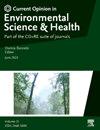The role of invasive alien species as bioindicators for environmental pollution
IF 6.6
Q1 ENVIRONMENTAL SCIENCES
Current Opinion in Environmental Science and Health
Pub Date : 2025-04-09
DOI:10.1016/j.coesh.2025.100620
引用次数: 0
Abstract
Invasive alien species (IAS) are significant drivers of biodiversity loss, threatening ecosystems through predation, competition, disease transmission, and habitat alteration. Recently, IAS have been proposed as bioindicators in environmental chemistry, offering an innovative approach to chemical pollution monitoring. Their adaptability, resilience, and widespread distribution enable the assessment of contaminant bioaccumulation, particularly in degraded habitats where native species are rare or protected, minimizing additional ecological stress. This mini-review examines the emerging use of IAS, such as bivalves, crustaceans, fish, mammals, and plants, in detecting a wide range of contaminants. A targeted literature search (2022–2024) identified 15 peer-reviewed studies demonstrating the potential of IAS in monitoring trace elements, persistent pollutants, and emerging contaminants. For instance, bivalves such as Dreissena polymorpha accumulate mercury, crustaceans like Procambarus clarkii reflect microplastic pollution, and semiaquatic mammals such as Myocastor coypus provide insights into wetland microplastic contamination through fecal analysis. However, IAS are not yet integrated into established biomonitoring programs and are currently used only in individual case studies or research efforts. The main limitation lies in physiological and ecological differences between IAS and native species, which can lead to variable bioaccumulation patterns and complicate ecological risk assessments. Additional challenges include ethical considerations, regulatory constraints, and methodological inconsistencies across studies. Addressing these challenges through refined protocols, molecular tools, and appropriate risk mitigation will be crucial for integrating IAS into environmental monitoring frameworks. This strategy can complement existing methods, improving chemical pollution tracking while supporting global efforts to manage contamination and protect biodiversity.
外来入侵物种对环境污染的生物指示作用
外来入侵物种(IAS)是生物多样性丧失的重要驱动因素,通过捕食、竞争、疾病传播和栖息地改变威胁生态系统。近年来,IAS被提出作为环境化学中的生物指标,为化学污染监测提供了一种创新的方法。它们的适应性、恢复力和广泛分布使评估污染物的生物积累成为可能,特别是在本地物种稀少或受保护的退化栖息地,最大限度地减少额外的生态压力。这篇小型综述审查了诸如双壳类动物、甲壳类动物、鱼类、哺乳动物和植物等IAS在检测各种污染物方面的新应用。一项有针对性的文献检索(2022-2024)确定了15项同行评议的研究,证明了IAS在监测微量元素、持久性污染物和新出现污染物方面的潜力。例如,双壳类动物如多形德雷塞纳(Dreissena polymorpha)会积累汞,甲壳类动物如克氏原螯虾(Procambarus clarkii)会反映微塑料污染,半水生哺乳动物如河狸鼠(myastor coypus)通过粪便分析提供了对湿地微塑料污染的见解。然而,IAS尚未纳入已建立的生物监测方案,目前仅用于个别案例研究或研究工作。主要限制在于外来外来物种与本地物种的生理和生态差异,这可能导致不同的生物积累模式和复杂的生态风险评估。其他挑战包括伦理考虑、监管约束和研究方法的不一致。通过完善的协议、分子工具和适当的风险缓解来应对这些挑战,对于将IAS纳入环境监测框架至关重要。这一战略可以补充现有的方法,改进化学污染跟踪,同时支持管理污染和保护生物多样性的全球努力。
本文章由计算机程序翻译,如有差异,请以英文原文为准。
求助全文
约1分钟内获得全文
求助全文
来源期刊

Current Opinion in Environmental Science and Health
Medicine-Public Health, Environmental and Occupational Health
CiteScore
14.90
自引率
0.00%
发文量
92
审稿时长
114 days
 求助内容:
求助内容: 应助结果提醒方式:
应助结果提醒方式:


